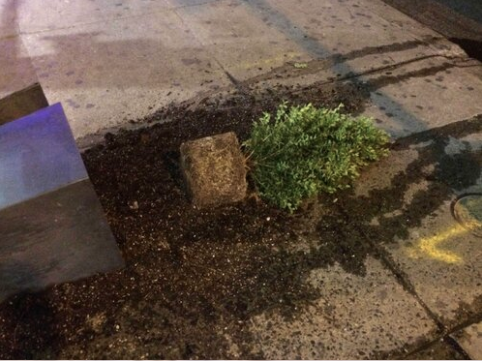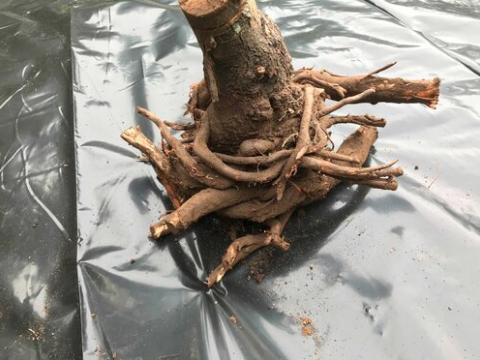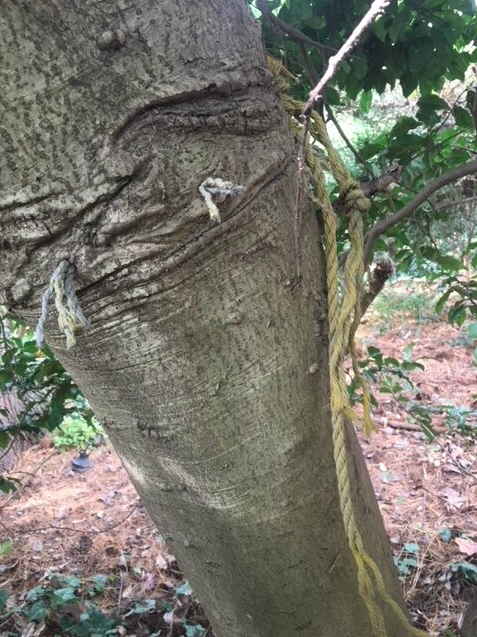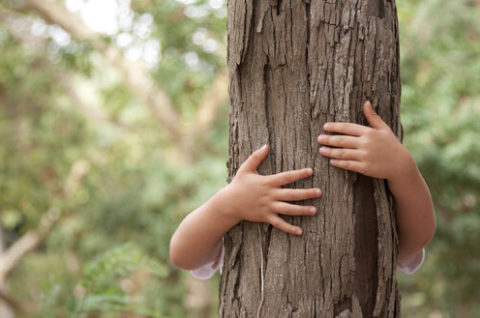This article was originally published on EFTE-Applied Research and Education
One of Eating for the Ecosystem’s values is “plants are people too;” but lately, I’ve been thinking of it also as “people are plants, too.” Just like people, plants deserve love, care, and understanding of how they like to be treated and what their needs are in times of transition. Just like plants, the roots young humans develop given their environmental conditions have long-term impacts on wellbeing.
The other day as we were installing viburnums and Mountain laurel at a woodland site, we found that the plants from the nursery were extremely pot-bound with badly kinked roots and root flare buried too deep under the soil. Unfortunately, it’s not uncommon for nursery conditions to lead to this type of growth. Like people, the plants develop in a way that reflects circumstance, context, environment. Any number of factors such as soil quality, container size, sunlight, watering habits, etc. can affect the roots of a baby plant. What happens when it’s time for a young container-bound plant to move to a new earthen home? As with humans, we know the world is larger than the home we grow up in, but we may find that as we start to fill out into possibility and fertile expanses of soil, perhaps there are some girdled roots, so to speak, getting in the way of healthy growth.

A good handful of landscapers out there would probably just install the plant as is, thinking it looked fine at first glance. And it’s true, in *some* cases perhaps the resilient plant would do fine, but in other cases the roots would continue to girdle and end up leading to sickness or short life. Before beginning work in the field of gardening and eco-landscaping, I didn’t know that, like people, sometimes you need to dig around a little bit to find out what’s really going on with the roots and growth patterns of a plant, and that this is a crucial step when transplanting a young shrub or tree.
As we examined the rootballs of the viburnums, we had to dig and scrape and work with the material to discover where the healthy roots were that we needed to keep and where the kinky roots were that would inhibit the plant from up-taking nutrients and living sustainably. This process reminded me of therapeutic frameworks and healing work. Through therapeutic and mindful practices, humans often find that within themselves, there are kinked roots (usually formed when developmental needs weren’t met or through childhood trauma, or perhaps stemming from generations-long familial trauma) amidst strong, healthy, resilient roots. We may have been planted in a new situation after childhood or experienced trauma and/or transition at various later stages of life and found that, perhaps surprisingly, some of our coping mechanisms can actually get in the way of living our healthiest possible lives.
I recently attended a workshop on the Hakomi Method of Mindful Somatic Psychotherapy. Fascinatingly, we learned with hands-on experience how someone with developmental trauma who hears a potentially nourishing phrase will often have some somatic response indicating that they are not quite able to uptake that nourishment. For example, this is a potentially nourishing phrase: “Your heart deserves to be taken care of.” Folks who are able to absorb this statement will report pleasant somatic feelings, or “that feels good,” or perhaps don’t feel much somatically at all. Folks whose life experience has been traumatic in some way relating to this phrase may report different kinds of pangs, pains, or swooshes of sensation in different parts of their body, perhaps connected with emotion. The body is not able to uptake the nourishment, and now the client and therapist can both see more clearly where the girdled or problematic roots may be.


Potbound roots should be redirected outwards or cut before planting
Although with humans it isn’t always so straightforward or possible to detangle or cut away the kinky roots when being transplanted, with plants it is something we can certainly do. Researchers have said that it is possible to cut away up to 90% of kinked roots at planting time and still have the plant thrive. The most important thing is to find the root flare at the base of the plant, make sure it is level with the top of the soil, and to get as many of the roots as possible to expand outwards rather than circling in on itself. This is a beautiful metaphor for humans as well: sometimes we need a little assistance getting organized inside and getting prepared to expand outwards.
Experience shows that plants with a significant amount of problematic roots removed during transplanting may look less beautiful in the first year, but in the long run will look more beautiful and will live longer than trees who were planted with rootball still potbound and girdled. This makes me think metaphorically of a larger scope of humanity. It feels to me that our society is in a big time of transition (maybe we always are, more or less)— that we’ve exposed a lot of kinky roots at our core. I think we’re still digging around and getting a feel for the shape of the rootball and the extent of the girdling. Yet, there is a sense of urgency. It’s time to cut away the problematic roots. I’m referring broadly to histories and persisting realities of racial, gender-based, and other types of oppression and violence, white supremacist and colonizer frameworks, human-first/domineering non-relational systems, and more. It may not appear to be a “beautiful” process for everyone, at first, as we snip such roots, but it’s crucial for a healthier and more just future. I wonder where our healthy collective roots are–how can we locate those and help them get stronger? To me, this often is the work of artists, myth-relayers, storytellers, and more: creative documents can help us examine where our kinky roots have sickened ourselves and where our strongest roots could grow us into uniquely graceful, robust, or resilient beings.
If you can keep following my societal metaphor here, or even the personal therapeutic metaphor, consider that there may be times we are dealing with an older, well-established tree rather than a young tree at planting time. Older trees, for a number of reasons, including but not exclusive to the poor initial planting and root conditions, may have sick roots or get sick in other ways. One technique arborists use to ease this is to do radial trenching. In addition to cutting away obvious and easy to locate girdled roots, we can dig holes between root flares to add nourishing organic matter and to aerate the soil. Like with older individuals or with habituated societal patterns, we can certainly still work to cut away the unhealthy and knotted roots. At the same time, we can infuse the context and individuals with nourishment, love, and support. We want to give them the best chance possible to thrive. Maybe plants and people are not so different, after all: we all need a healthy environment where we can safely grow to our fullest potential, and sometimes, when conditions weren’t perfect, we need a little extra -or maybe a lot of- TLC at various stages of life to help us revivify.


